Rikyū’s Memorial
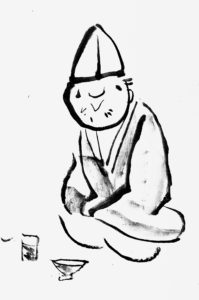
Sen no Rikyū’s life was much more important than his death, though his birth day is uncertain. However, curiosity prompts speculation about his death. Rikyū had in some way provoked enmity with Toyo-tomi Hide-yoshi, 豊臣秀吉, Excellent-retainer Surpassing-joy, who demanded that he commit seppuku, 切腹, cut-belly. There is some thought that Hideyoshi, urged by Rikyū’s friends, did pardon him, but Rikyū did kill himself.
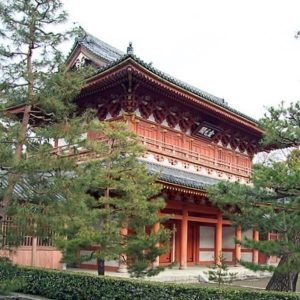
The cause of Hideyoshi’s ire is thought to have been prompted by a sculpture of Rikyū installed in the great gate of Daitokuji, in 1589, by the abbot in thanks for contributing the second story of the unfinished gate. Hideyoshi in a rage having to walk under the feet of Rikyū, ordered the temple to be burned to the ground. That didn’t happen. Rikyū’s death was in 1591, which makes the delay of nearly two years since the death decree, so that the statue may not have been the problem. After his death, Rikyū’s severed head was publicly displayed on a pike, the statue was thrown into Kyōto’s Kamo River. This ignominious fate was not uncommon in Rikyū’s time. The head of Rikyū’s statue is preserved at Omotesenke, and the wooden body, with a recreated head is enshrined in Urasenke’s Rikyū’s chapel. A recreation of Rikyū’s original statue is in the upper story of Daitokuji’s great gate, where was intended, and in the company of 16 Buddhist arhats.
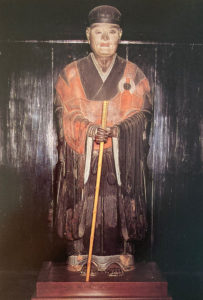
Rikyū’s suicide was on lunar 2 gatsu/month 28 nichi/day in 1591. That was a leap year, with an additional month added between lunar 1st and 2nd month. The lunar 2nd month 28th day coincided with solar calendar date of April 21st. In 2023, because of the added lunar month, the lunar 2nd month 28th day coincides with April 18th.
According to the Gregorian calendar, a month that has two full moons, the second is called a blue moon, in Katakana, ブルームーン. A blue moon can also refer to the third full moon in a season. In the western calendar, an extra day is added at the end of February every 4 years, whereas a full month is added to the lunar calendar, uru-zuki, 閏月, intercalary-moon/month, near the time of the year that best corresponds with adjustment to occurrences of the equinoxes and solstices. It is necessary to have an additional month during a solar year, to adjust a closer coincidence of lunar events and the solar year. To avoid conflict, most people avoid observing the uru-doshi, 閏年, intercalary year, and follow the solar calendar. It becomes obvious that experts need to provide the necessary details of calendar events. Many Japanese have little concern for the lunar kyū-reki, 旧暦, old-calendar.
For the last Tea presented before his suicide, Rikyū displayed in the tokonoma na-no-hana, 菜の花, rape-’s-flower.
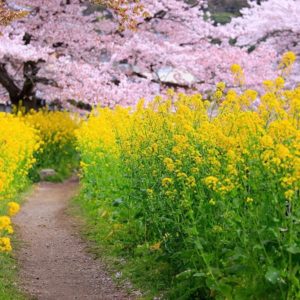
Rapeseed flowers, u-no-hana, 菜の花, rape ’s flower, a member of the cruciferous family, are in bloom from early spring. Plant height is usually 50-80 cm, and left alone it grows rapidly, and reaches up to 100 cm.
Seeds contain a lot of oil and are used as edible oil. Rapeseed oil, na-tane-abura, 菜種油, has been used for illumination in abura–zara, 油皿, oil-dish, lamps, for centuries in Japan. The oil, any oil, is burned in wicks called tō-shin, 灯心, lamp-wick. The wick does not burn, but through capillary action, the oil fuels the flame.
Around mid-April, nanohana attains a maximum height, and the single stalk has buds at the top, with open flowers a little lower on the stalk, followed by full flowers, faded petals, and finally, seeds in various stages of development. A single plant represents a full life cycle, which may have influenced Rikyū to use it for his final Tea.
Several aspects of the nanohana are contrary to Rikyū’s precepts on the nature of Cha-bana, 茶花, Tea-flowers. One precept is that the chabana flower is not edible, and nanohana is part of the Japanese diet, and is one of Japan’s favorite tsuke-mono, 漬物, pickle-thing. Flowers are traditionally not displayed in the tokonoma at night, because the glowing embers of the oil lamp and candle wick, tō-shin, 灯芯, lamp-wick, is called hi-bana, 火花, fire-flower, so that there is no need of another flower. Rapeseed oil is fuel for oil lamps.
The tōshin is made from the pith of i-gusa, 藺草, rush-grass, that is used to make the surface of tatami. The Kanji for wick, 芯, is composed of grass and heart, which is quite poetic, as the igusa’s heart, or pith of the grass, is used as the surface of tatami. It might be remembered that when the Buddha sought enlightenment, he sat on some grasses that are likened to the igusa of tatami. It is interesting to note that the grasses lead to enlightenment, and the heart of the grass is used as wicks of oil lamps.
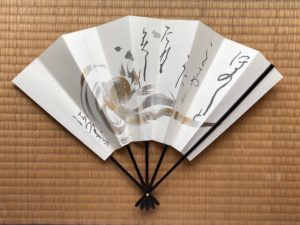
Calligraphy:
Ho no bo no to komayaka ni dare mo utsukushii ShiotsukiYaeko
ほのぼのと こまやかに だれも うつくしい 塩月やこ
Warmly in modesty everyone is beautiful.
The silver and gold nami, 波, wave, was designed by Tan-tan-sai, 淡々斎, Light-light-abstain, XIV Iemoto of Urasenke: father of Yaeko. The Cha-mei, 茶名, Tea-name, of Shiotsuki Yaeko, older sister of Hō-un-sai, 鵬雲斎, ‘Phoenix’-cloud-abstain, XV Iemoto, Urasenke, is Sō-shin, 宗芯, Sect-wick. It should be remembered the ‘wick’ is composed of grass or plant and heart. Shiotsuki Sama’s heart was ablaze with Tea.
In lieu of flowers for a night time Tea, a ceramic bowl containing some plants of seki-shō, 石菖, stone-flag, inserted in a piece of charcoal set in water. The sekishō is believed to clean the air, as well as providing a slight fragrance. There are strong parallels between the sekishō in charcoal in a bowl of water and a kō-ro, 香炉, incense-hearth, and its piece of burning charcoal in a bed of ash.

